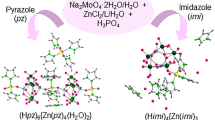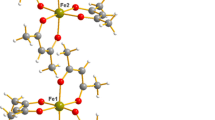Abstract
The new compounds Zr(SeO4)2·H2O and Zr(SeO4)2·4H2O were synthesized at low-hydrothermal conditions (teflon-lined steel vessels, 220 °C) from mixtures of Zr2O2(CO3)(OH)2, H2SeO4, and minor contents of water. Colorless single crystals up to 0.2 mm in length, obtained within 1 week, were studied by single-crystal X-ray techniques. Zr(SeO4)2·H2O crystallizes in the monoclinic space group P21/n (no. 14), with a = 5.332(1) Å, b = 7.962(2) Å, c = 16.256(3) Å, β = 92.19(1)°, V = 689.6(3) Å3, Z = 4, and R1 = 0.0195. Zr(SeO4)2·H2O represents a new structure type built from isolated ZrO7 pentagonal dipyramids, further cornerlinked via SeO4 groups to a three-dimensional framework. One H2O group acts as a ligand of the ZrO7 coordination. Zr(SeO4)2·4H2O [orthorhombic, space group Fddd (no. 70), with a = 5.651(1) Å, b = 11.964(3) Å, c = 26.611(6) Å, V = 1799.1(4) Å3, Z = 8, and R1 = 0.0177] is isotypic with the compounds M(SO4)2·4H2O; M = Zr, Hf, Ce, and Pu. The structure is built up by sheets within (001), linked by hydrogen bonds only. The zirconium atom is 8-coordinated to oxygen atoms of four H2O molecules and of SeO4 tetrahedra, forming a distorted tetragonal antiprism. For both structures, mean cation-oxygen bond lengths are in accordance with the literature: Zr[7]: 2.137 Å, Zr[8]: 2.188 Å, and Se[4]: 1.631–1.635 Å. Observed hydrogen bonds show donor–acceptor distances within the range of 2.65–2.79 Å.
Graphical abstract




Similar content being viewed by others
References
Ahmed MAK, Fjellvåg H, Kjekshus A (1999) Acta Chem Scand 53:24
Giester G, Wildner M (1992) Neues Jahrb Min Monatsh 1992:135
Wildner M, Stoilova D (2003) Z Krist 218:201
Pristacz H, Talla D, Preuschl F, Giester G, Wildner M (2014) Neues Jahrb Min Abh 191:215
López-Moreno S, Errandonea D, Rodríguez-Hernández P, Muñoz A (2015) Inorg Chem 53:1765
Errandonea D, Muñoz A, Rodríguez-Hernández P, Proctor JE, Sapiña F, Bettinelli M (2015) Inorg Chem 54:7524
Giester G, Wildner M (1991) J Sol State Chem 91:370
Steinhauser G, Luef C, Wildner M, Giester G (2006) J Alloys Compd 419:45
Giester G, Wildner M (2015) Acta Crystallogr A 71:s356
Singer J, Cromer DT (1959) Acta Crystallogr 12:719
Casari BM, Langer V (2007) J Sol State Chem 180:1616
Wilson RE (2011) Inorg Chem 50:5663
Kalaji A, Skanthakumar S, Kanatzidis MG, Mitchell JF, Soderholm L (2014) Inorg Chem 53:6321
Bear IJ, Mumme WG (1970) Acta Crystallogr B 26:1125
Bear IJ, Mumme WG (1970) Acta Crystallogr B 26:1131
Brese NE, O’Keeffe M (1991) Acta Crystallogr B 47:192
Sheldrick GM (2008) Acta Crystallogr A 64:112
Acknowledgements
The authors are grateful to two anonymous reviewers for their helpful comments.
Author information
Authors and Affiliations
Corresponding author
Rights and permissions
About this article
Cite this article
Giester, G., Wildner, M. Contributions to the stereochemistry of zirconium oxysalts—part I: syntheses and crystal structures of novel Zr(SeO4)2·H2O and Zr(SeO4)2·4H2O. Monatsh Chem 149, 1321–1325 (2018). https://doi.org/10.1007/s00706-018-2226-7
Received:
Accepted:
Published:
Issue Date:
DOI: https://doi.org/10.1007/s00706-018-2226-7




